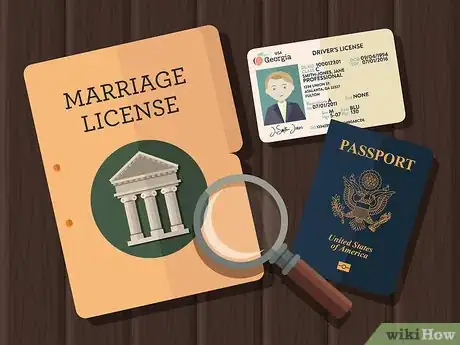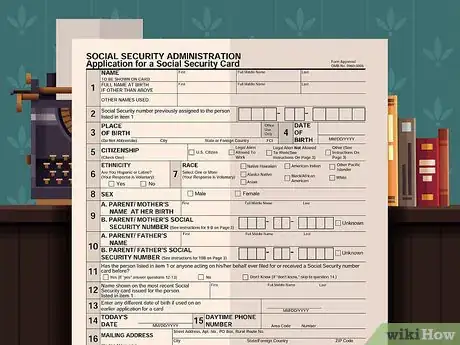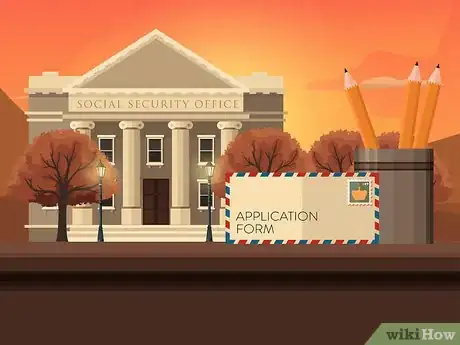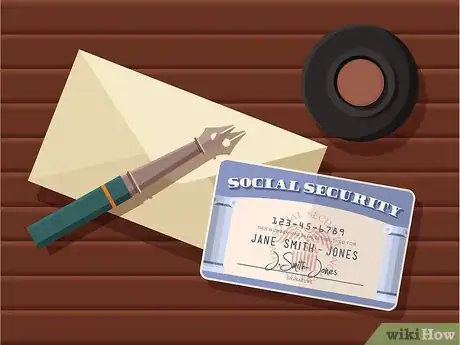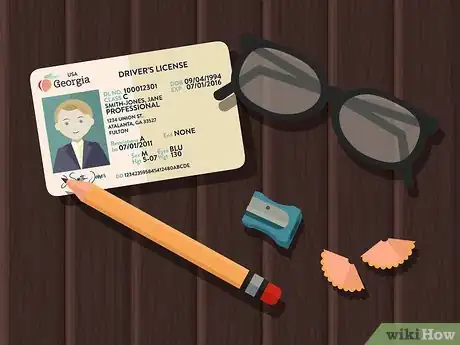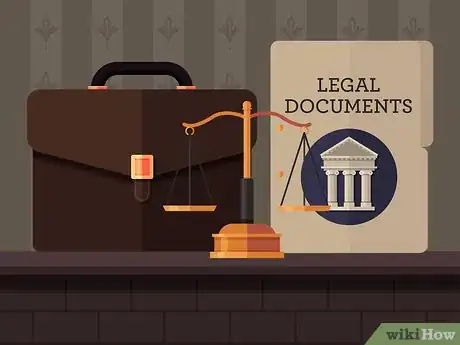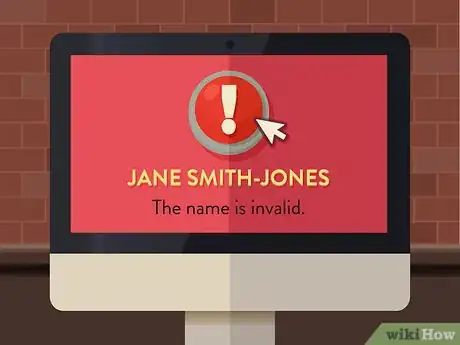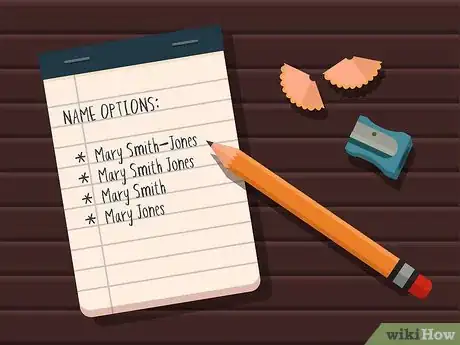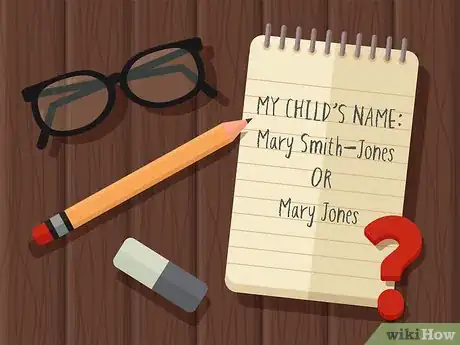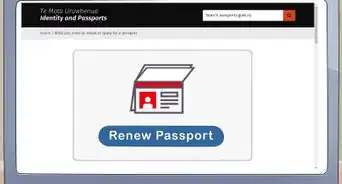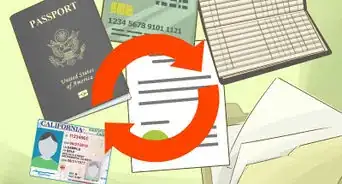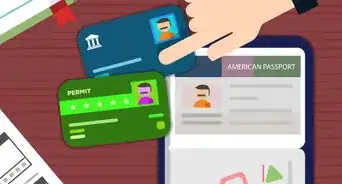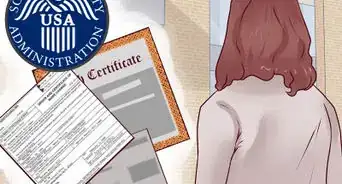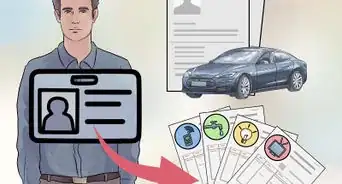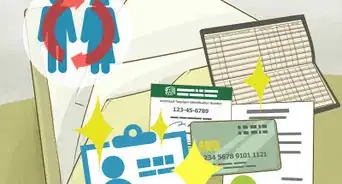This article was co-authored by wikiHow Staff. Our trained team of editors and researchers validate articles for accuracy and comprehensiveness. wikiHow's Content Management Team carefully monitors the work from our editorial staff to ensure that each article is backed by trusted research and meets our high quality standards.
There are 15 references cited in this article, which can be found at the bottom of the page.
This article has been viewed 91,734 times.
Learn more...
Hyphenating your last name is one way people choose to change their names after getting married. Once you change your name to a hyphenation, though, that's just the beginning. You have to change it with other organizations, such as the Social Security Administration, and you have to deal with the ramifications privately and professionally.
Steps
Changing Your Name With the Social Security Administration
-
1Have your proof ready. When changing your name on your Social Security card, you need to have proof of your new name. Because you are likely changing your name because of marriage, the best document is a marriage license that shows your new name.[1]
- You'll also need proof of identity, such as a state-issued ID or driver's license or a passport. In some cases, other forms of ID can be substituted, such as an employee or school identification card or a military identification card.[2]
- If you don't change your name with Social Security, it can affect government services. For instance, the IRS won't recognize your hyphenated name if it's not the one that's associated with your Social Security Number.
-
2Obtain the form. You can print out the form online. You can also get the form at your local Social Security office. Either way, you must turn the form in physically in person or by mail, so you must have a physical copy.[3]Advertisement
-
3Fill in the form. You will need to fill in some basic biographical information. For instance, you'll need to include your address, Social Security Number, and place of birth. Nonetheless, the form is fairly short and shouldn't take you very long to complete.[4]
- Be sure to read the instructions ahead of time. For instance, you only need both parent's Social Security Numbers if you are applying for a brand new card for someone under 18. In this case, then, you don't need both parent's Social Security Numbers, but those are still blanks on the forms.[5]
-
4
-
5Wait for your new card. Your card should arrive by mail. As long as you filed all the necessary documents, it should be at your house in about a week and a half.[8]
Changing Your Name Elsewhere
-
1Change your driver's license. Even though your name is similar to your old name, you need to change it on your driver's license. How you change it depends on your state. Usually, you'll have to change your license in person.[9]
- Before going to your local department of motor vehicles, check online or call to see what you'll need. Usually, you'll need to fill out a form for renewal or name change. The name of the form will vary by state. You'll also be asked to pay a fee.[10]
- Most of the time, you won't need your Social Security card first. You will need your old driver's license and proof that you changed your name, which is your marriage license in most states.[11]
- You'll also need to change the information on your car's registration and title.[12]
-
2Change all legal documents. When you change your last name, that means you need to make all your legal documents match. For instance, you need to change your name on your insurance and at your bank. All of your bills need to have your new name.
- Have your marriage license ready so you can show that you changed your name. Some places may require your new Social Security card.
- Try to think of all your bills, not just the ones you pay monthly. For instance, you may forget to change your name on your toll pass if it's not coming out monthly.
- Also, remember to change your name at places like your doctor's office, as they will be looking for your insurance under your old name if you don't.
-
3Think about social media. Another issue you need to think about is social media. You can change your name as you see fit. You're not required legally to do so, but you can change your name on major social media platforms and blogs.
- However, if you have a specific URL (website address), changing that will be more difficult and time-consuming than just changing your name on the account. On some social media platforms, you may not be able to change it.
- Some websites do have limits on how often you can change your name, so make sure you are ready to change it when you do.
Using Your Hyphenated Name Day-to-Day
-
1Decide which name you want to use professionally. If you have been known under a certain name professionally, you can still keep using that name as long as your legal documents are under your legal name. However, you can also switch over to your new hyphenated name.[13]
- Some women keep using their maiden name because they are well-known in their community under that name. For instance, if you're a local author or real estate agent, it may be better to keep using your maiden name.[14]
- If you've gotten married, though, and many people know about your marriage, you should clarify how you want to be known from now on. Many people will assume you're taking your husband's name solely.[15]
-
2Clarify you have a hyphenated name. When making appointments or reservations, it's important to clarify you have a hyphenated last name to make it easier for the other person. If you don't, the other person may try to mash your name into some sort of bizarre hybrid, plus you're giving them a heads' up about the punctuation.[16]
- For example, you could say, "Are you ready for my last name? It's hyphenated. It's Smith-hyphen-Jones."
-
3Be prepared for other problems. For instance, hyphenated names can cause issues with computer systems sometimes, which may not recognize the hyphen in a name field or may not know how to classify the name properly.[17] Other times, forms are too short to fit your name, or you may find that an email address has a character limit shorter than your hyphenated name.[18]
- Nonetheless, hyphenated names do have some pluses. For instance, hyphenating usually creates a unique name, meaning no one else is likely to have your first and last name combination.[19]
Deciding What Name to Give Your Children
-
1Discuss the options. When naming your kids, you do have several options. You can give them either one of the parent's original surnames. You can also give them the hyphenated name. Some parents form hybrid names, so the kid isn't stuck with a hyphenated name.[20]
-
2Giving your child either your surname or your spouse's is a good option if one of you feels more strongly about carrying on your family's name.[21]
- For instance, it can also create identity issues, as your kids' names are not technically the same as your name, if you have a hyphenated name.
-
3Consider identity. While younger kids may not have a problem with having different last names from one of their parents, as kids get a little older and go to school, they may start making comparisons with other kids. It can be confusing to them to have a name that is not the same.[22]
- They may also get questions from other kids about their last name, and why it's not the same as one parent or the other.
- Names connect families, and having the same name can show kids that they belong.
-
4Understand why hyphens can cause problems. Sometimes, hyphenated names present their own set of problems for kids. For one, many kids have trouble learning to spell out longer names when they're first learning to write.[23]
- Hyphenation can also cause administrative issues, since some places are unsure whether to file under the first surname or the second surname.[24]
- It can also cause future problems, if the kid decides he or she wants to hyphenate last names later, as that adds a third surname to the mix.
Community Q&A
-
QuestionWhich name is okay to drop if hyphenated, first or second?
 Community AnswerNeither. If someone's name is hyphenated, then it is polite and respectful to pronounce both.
Community AnswerNeither. If someone's name is hyphenated, then it is polite and respectful to pronounce both. -
QuestionWhen alphabetizing hyphenated names, do I use the first or second name?
 Community AnswerYou use the first name.
Community AnswerYou use the first name. -
QuestionWith a hyphenated name, do I use the first or second name?
 Community AnswerIt is better and more respectful to use both in the beginning. If the person tells you you can just call him one of the names, only then would it be okay. If he doesn't correct you, continue using the two names.
Community AnswerIt is better and more respectful to use both in the beginning. If the person tells you you can just call him one of the names, only then would it be okay. If he doesn't correct you, continue using the two names.
References
- ↑ https://www.ssa.gov/ssnumber/ss5doc.htm
- ↑ https://www.ssa.gov/ssnumber/ss5doc.htm
- ↑ https://faq.ssa.gov/en-us/Topic/article/KA-01981
- ↑ https://www.ssa.gov/forms/ss-5.pdf
- ↑ https://www.ssa.gov/forms/ss-5.pdf
- ↑ https://secure.ssa.gov/ICON/main.jsp
- ↑ https://secure.ssa.gov/ICON/main.jsp
- ↑ https://faq.ssa.gov/en-us/Topic/article/KA-02196
- ↑ http://www.dol.wa.gov/driverslicense/namechange.html
- ↑ https://www.flhsmv.gov/ddl/faqkeys.html#2ndDoc
- ↑ http://www.dol.wa.gov/driverslicense/namechange.html
- ↑ http://www.dol.wa.gov/driverslicense/namechange.html
- ↑ http://www.marriagenamechange.com/blog/hyphenating-last-name/
- ↑ http://www.marriagenamechange.com/blog/hyphenating-last-name/
- ↑ http://www.marriagenamechange.com/blog/hyphenating-last-name/
- ↑ http://thestir.cafemom.com/love_sex/176123/hyphenated_last_name_marriage_husband
- ↑ http://www.marriagenamechange.com/blog/hyphenating-last-name/
- ↑ http://thestir.cafemom.com/love_sex/176123/hyphenated_last_name_marriage_husband
- ↑ http://www.nytimes.com/2011/11/24/fashion/babies-surnames-to-hyphenate-or-not.html?_r=0
- ↑ http://www.nytimes.com/2011/11/24/fashion/babies-surnames-to-hyphenate-or-not.html?_r=0
- ↑ http://www.babycenter.com/0_whose-last-name-should-you-give-your-baby_10327041.bc
- ↑ http://www.todaysparent.com/pregnancy/baby-names/two-surnames-with-love-choosing-your-childs-last-name/
- ↑ http://www.todaysparent.com/pregnancy/baby-names/two-surnames-with-love-choosing-your-childs-last-name/
- ↑ http://www.babycenter.com/0_whose-last-name-should-you-give-your-baby_10327041.bc
